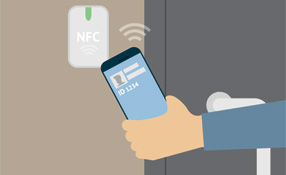 |
| Airports, metro systems and other transportation centers must deploy multiple layers of access control for restricted areas |
HID Global’s IP-based networked access solutions deliver security in the transportation sector while also moving intelligence to the door, streamlining system monitoring, management and reporting via standard web browsers, and enabling access control to be integrated with video surveillance and other systems. These solutions help deliver real-time monitoring and data management while enabling role-based access control settings to manage staff access at key entry points and restricted areas.
IP-based access control is becoming increasingly important for the transportation vertical, says Jeremy Hyatt, director of marketing, HID Global. It improves security by enabling a physical access control system (PACS) to be integrated with other solutions on the same network. When subsystems – including video management, access control, video analytics, intrusion devices and all associated IP-based edge devices – are managed through one user interface, situational awareness is enhanced. All information can be immediately combined and correlated. This is particularly important for metro rail and other transit operations.
 |
| iCLASS access control readers and contactless smart cards include extra-secure printing features |
Operators must be able to prevent unauthorized entry and manage access to all stations and electrical substations, as well as the parking lots and major facilities at metro line sections. The same systems must also protect equipment and staff at locations including fixed plants, offices, equipment areas, machine rooms, and automatic fare collection (AFC) system management offices, as well as the central station, communications equipment room and other public areas. It may also be important to centrally monitor passage areas and locations housing equipment management facilities. Finally, access control systems also must frequently span an extensive network, and accommodate cardholder information from various entry points using a wide range of access control rules that must be transmitted to the central station.
HID Global has a history of successful airport security implementations, most notably Latin America’s busiest airport, the International Airport of Mexico City (Spanish: Aeropuerto Internacional de la Ciudad de México, AICM). As a tourist and commercial gateway to the country, the airport plays a vital role in the development of Mexico’s economy. The AICM turned to HID Global to address its mission-critical requirements with iCLASS access control readers and contactless smart cards that include extra-secure printing features.
Another example is Beijing’s public transport system, which uses HID Global’s centralized, web-based access control system to monitor stations and site equipment in real-time. HID Global has provided the Beijing public transport system with a centralized, top-to-bottom, web-based access control system to enable monitoring of all stations and site equipment in real-time. Readers can be installed where they are needed, and connected to a network controller for central access management and report generation. All central management functions can be performed at the metro line control center, which consists of a central server, an access authority management station, a central station, and all associated system software. The central station administrator can track and manage door access in all metro stations, improving flexibility and speeding response to network failures. Meanwhile, controllers enable every metro station office to monitor its own system’s real-time status, entry records and card access information. This approach ensures maximum flexibility and the fastest possible response to network failures, with all operations protected by multi-layer security and failover support.









































